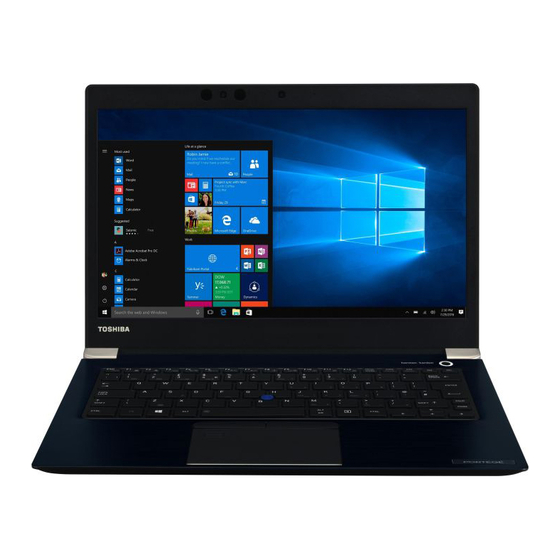
Table of Contents
Advertisement
Quick Links
Advertisement
Chapters
Table of Contents

Summarization of Contents
Legal, Regulatory, and Safety
Copyright, Disclaimer, and Trademarks
Manual copyright, liability disclaimers, and trademark notices.
Regulatory Information
Compliance with FCC, EU, and other regional regulations.
Product Disposal Guidelines
Procedures for environmentally sound disposal of product and batteries.
Software License Information
Licensing terms for video standards and OpenSSL/FreeType software.
Getting Started
Equipment Checklist and Conventions
Items included in the package and manual formatting conventions.
Initial Computer Setup and Startup
Basic steps for initial setup, connection, and startup.
Power Management Modes
Procedures for shutting down, restarting, Sleep, and Hibernation modes.
System Recovery Options
Creating and restoring system recovery media for data backup.
The Grand Tour
Computer Component Overview
Identification of external computer parts like ports, speakers, and indicators.
Internal Hardware Components
Description of key internal hardware like CPU, RAM, and storage.
Power Indicators and Descriptions
Explanation of DC IN/Battery and Power status indicators.
Operating Basics
Touch Screen and Touch Pad Usage
Interaction methods using touch screen gestures and touch pad functions.
Keyboard and Pointing Device Operation
Using the keyboard, function keys, and AccuPoint pointing device.
Fingerprint Sensor Usage
Enrolling and using the fingerprint sensor for authentication.
Battery Management and Charging
Battery types, care, charging, monitoring, and maximizing operating time.
Memory Media and Smart Card Usage
Inserting, removing, formatting, and caring for memory media and smart cards.
Connectivity Ports and Adapters
Using HDMI, USB-C ports, adapters, and LAN connectivity.
Audio and Video Settings
Configuring volume, microphone, sound effects, and video modes.
Utilities and Advanced Usage
Pre-installed Utilities Overview
Overview of utilities like Password, System Settings, Setup Utility, and eco Utility.
Advanced Computer Features
Description of special features like automatic power off, sleep modes, and passwords.
Password Management
Setting and managing user and supervisor passwords for system access.
USB Power Features
Utilizing USB ports for charging devices and Sleep and Charge functionality.
TOSHIBA Setup Utility
Accessing and configuring BIOS settings for system initialization.
Troubleshooting
Problem-Solving Process and Analysis
Guidelines for identifying and resolving computer problems systematically.
Common Hardware and Startup Issues
Troubleshooting steps for keyboard, program response, and startup failures.
Component-Specific Troubleshooting
Detailed troubleshooting for power, display, storage, media, pointing devices, and network issues.
Appendix
Technical Specifications
Details on physical dimensions, environmental requirements, and power specifications.
Wireless Device Information
Interoperability, health considerations, and technology details for wireless devices.
Intel AMT Configuration
Setup and management of Intel Active Management Technology for system administration.
Technical Notes and Glossary
Legal footnotes, CPU performance notes, memory, and glossary definitions.
Critical Safety Instructions
Battery Handling and Safety Precautions
Essential safety instructions for battery usage, charging, and disposal.
Product Integrity and Power Cable Safety
Warnings against product modification, disassembly, and proper power cable handling.
Wireless Functionality Safety
Guidelines for turning off wireless functions near medical devices and in specific environments.
Environmental and Physical Hazard Warnings
Warnings about choking hazards, liquids, moisture, and physical environment risks.
Display and Surface Safety Precautions
Precautions for display screen handling and product placement on surfaces.
Operational Safety Rules
Safety rules for software operation and data transfer during power changes.
Ergonomic Recommendations
Guidelines for comfortable and safe posture and workspace setup.










Need help?
Do you have a question about the Satellite X40-D Series and is the answer not in the manual?
Questions and answers